- Free Resources
- Register for Free
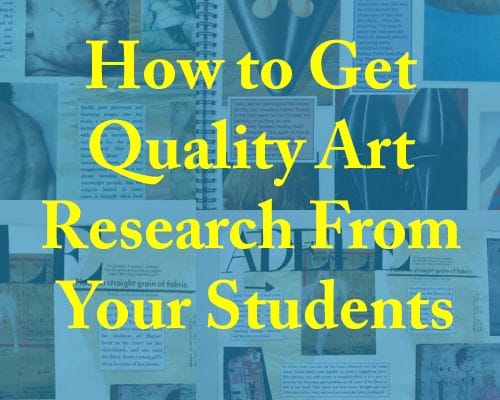

How to Get Quality Art Research From Your Students
Isn’t it annoying when you see a beautifully presented research page and then quickly realise the information is just chunks of info that have been cut and paste from the internet? Where’s the stickability in that? They are not going to retain it for long. How do you get quality art research from all of your students? Here are a few solutions for extracting quality research from your classes.
Set Questions
I’ve been guilty of saying “Research 10 facts on [insert artists name here]” and this has produced exactly the wrong result described above. A much better approach is to set specific questions that you would like them to research. Of course, this is time-consuming, but once you have created them for a particular artist, you’ve always got them, and it makes your students hunt for the information.
You might want to give them a passage of information to work from or to direct them to a particular website. There are many child-friendly websites such as Ducksters that have artist biographies.
I have used crosswords for the homework prior to asking students to make a research page on an artist. This way they have already done some research and it usually raises the quality of the information or annotation on the research pages. There is a growing bank of crosswords on The Arty Teacher just click the image below to learn more.
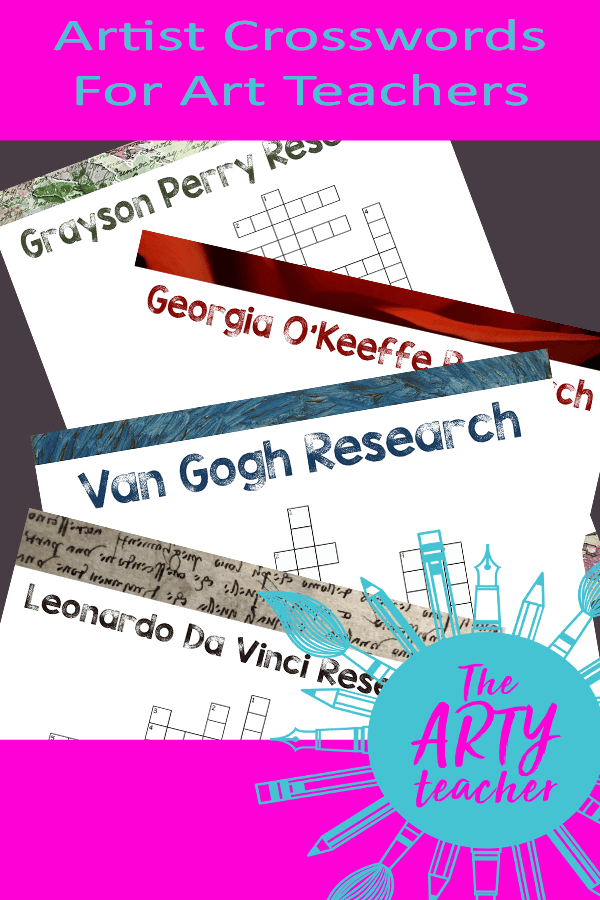
Teach About Chronology
The sort of research pages I ask students to make have pictures and facts spread across them. I’ve seen a few research pages over the years where students tell me all about an artists death and then they go on to tell me, lower down the page, about an exhibition the artist has had. Was this the ghost of the artist? Teaching your students about how we scan down a page from top to bottom and from left to right is a good idea.
Personal Response
How do you get quality art research that includes a personal response? Do you want your students to add their personal response to a research page or do you just want facts? If you want a personal response, what do your students think about the artists work? Do they like or dislike it? Can they talk about a particular artwork that they like? Do you want them to include subject-specific language? If they had to make work in the style of the artist what would they create? The year group or grade you teach might influence what approach you take.
Explain how you will be assessing the research page that they create. This could be a simple list of what needs to be included plus extra marks for presentation. You or your school might want to have an emphasis on grammar and punctuation. You might want to highlight that neat cutting out and sticking down of the artist’s work is part of good presentation. You might want them to reflect the artists work in the way they create the research page. Different art departments have different ways of doing things. Sharing what you are looking for and how it will be assessed is good practice and will appeal to students who are hungry for good grades. Having a good example to show them is a great way to raise the standard. There are many assessment resources for art teachers on The Arty Teacher website.
Art Literacy
Are there keywords that you would like them to include? If I was asking students to create a research page on Matisse I might insist that their work includes the words Fauvism, oil paint, France or French, and Cut-Outs. You could take this approach with many artists and topics to make sure literacy is embedded in the homework you set.
Stand Up – Sit Down!
This is a fun game to encourage in-depth research and longer-term retention of information. You ask your students to research a minimum of ten facts about an artist. They can do this in rough at the back of their sketchbooks. You tell them that they will be playing a game at the start of the next lesson and that they will not be able to look at their facts when they play it. At the start of the next lesson, you give them 3 or 4 minutes to look at their facts. This acts as revision as they have already researched these facts at home. Research shows revisiting information is essential to remembering information. You then ask them to close their books. Then, all the students stand up. You randomly choose a student to say the first fact. They say it and then choose the next student to say a fact. To start with, they have to choose a student who has not been chosen. Each student states a fact until they can’t. When they can’t they have to sit down. The choice goes back to the previous student to choose another student. Eventually, only a few students will be left standing and you keep playing until there is only one student left standing and they are the winner. My students have loved this game!
The download below ‘Research Page Do’s & Don’ts’ is an editable list of things you would like your students to include on a research page and things you would like them not to do. I get all my students to stick this in the back of their sketchbooks and it has really raised attainment.

I’m certain if you use some of these strategies you will see quality art research pages coming your way. I’d love to hear what strategies you’ve found success with. Please comment below to share your good ideas with art teachers around the globe!
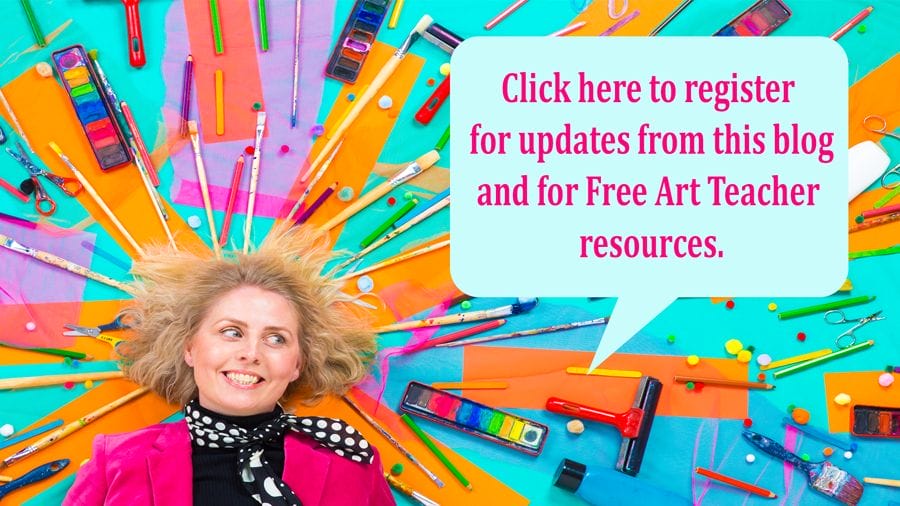
Enjoy this article, Drop it a like
Or share it.
The Arty Teacher
Sarah Crowther is The Arty Teacher. She is a high school art teacher in the North West of England. She strives to share her enthusiasm for art by providing art teachers around the globe with high-quality resources and by sharing her expertise through this blog.
Leave a Reply Cancel reply
Your email address will not be published. Required fields are marked *
Sign me up for the newsletter!
Blog Categories
- Art Careers 42
- Art Lesson Resources 21
- Arty Students 5
- Inspiration 63
- Pedagogy 37
- Running an Art Department 19
- Techniques & Processes 47
More Resources you might like...
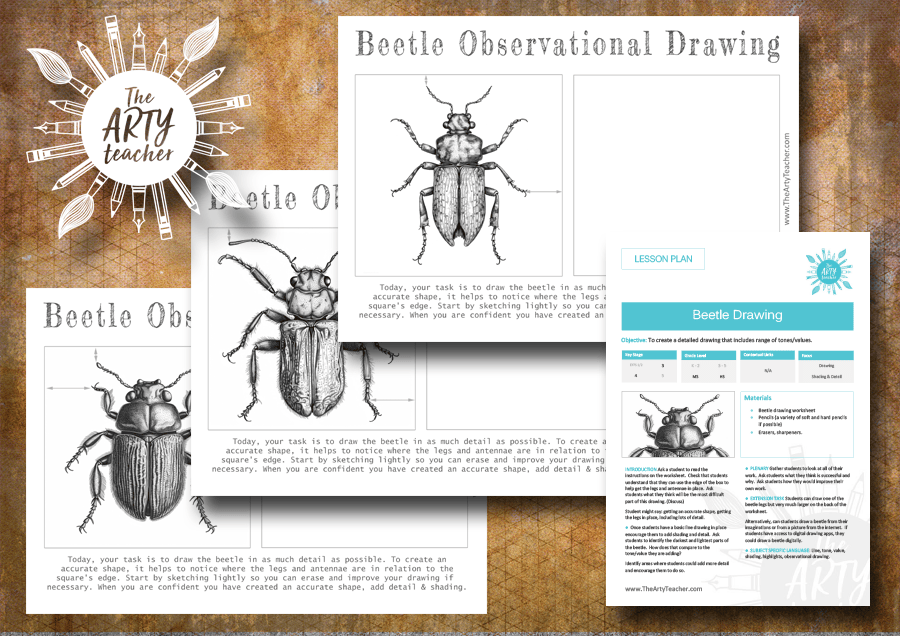
Subscribe & save in any currency! I WANT TO PAY IN Australian Dollars ($) Canadian Dollars ($) Euros (€) Pound Sterling (£) New Zealand Dollar ($) US Dollars ($) South African rand Change Currency
Basic subscription free.
Register and you can download 3 of the Free Resources Every Month!
Premium Subscription $9.99 Per month $99 Per year
Save money and get 10 resources of your choice every month. The yearly subscription is the best value.
School Subscription Free Per year Free Per year Free Per year Free Per year Free Per year Free Per year Free Per year Free Per year Free Per year
For departments with 2 or more members. Subscribe for a total of 2 teachers to download 10 resources each month.
Privacy Overview
How to annotate a sketchbook: a guide for art students
Last Updated on November 29, 2021
High school art students often have to submit sketchbooks, art journals, or other preparatory material that includes writing as well as visual material. This annotation plays an important role in how examiners assess and respond to your work. Although each qualification has their own assessment criteria and requirements, almost all high school art programs have similar standards and expectations when it comes to annotation. This article sets out best practice when it comes to producing outstanding sketchbook annotation, and includes examples from students who achieved excellent results around the world. It is likely to be particularly helpful for students who are wondering how to annotate an A Level Art sketchbook, those wishing to conduct formal analysis for an IB Visual Arts Process Portfolio, or those looking for GCSE Art annotation examples.
Want more guidance? Some of this material and much more is in our new book: Outstanding High School Sketchbooks . This book has high-resolution images so that fine details and annotation are clear, making it an excellent resource for students and schools. Learn more !
Communicate intentions
It is helpful to begin a sketchbook by discussing your intentions, initial ideas, or design brief, including any requirements and restrictions set for the project. (Some students also include brainstorming and mind maps at this stage of their project).
READ NEXT: How to make an artist website (and why you need one)


Demonstrate subject-specific knowledge
Aim to communicate your thoughts in an informed, knowledgeable manner, using a range of art-related vocabulary and terminology. This knowledge may be the result of formal classroom lessons, individual research, or personal art-making experience.

Include personal responses
Aim to record personal reflections, evaluations, and judgments, rather than regurgitating facts or the views of others. The aim is to provide insights into your thinking and decision-making processes. Visual art examiners do not want to read long lists of facts, excessively detailed descriptions of technical processes, extensive artist biographies, or long-winded passages documenting broad periods of art history. Use research to inform your own responses. It is not acceptable to copy written information directly from other sources, although small portions may be quoted and referenced.

Avoid the obvious
Self-explanatory statements—such as ‘this is a drawing of a shoe’—are unnecessary. Such comments do not communicate any new information to the examiner.

Communicate with clarity
Write in a succinct and clear manner. A sketchbook should not contain endless pages of waffle; this wastes the examiner’s time as well as your own. You can record thoughts in any combination of legible formats: mind maps, questions, bulleted summaries, or complete sentences and paragraphs. Whichever format you choose, avoid ‘txt’ language and ensure that you proofread for spelling errors. These indicate carelessness and may suggest that the work belongs to a low-caliber student.
Don’t feel you have to write in full sentences. Noting key words or phrases can be just as effective. Annotating your work, GCSE, Art & Design, BBC Bitesize Guides
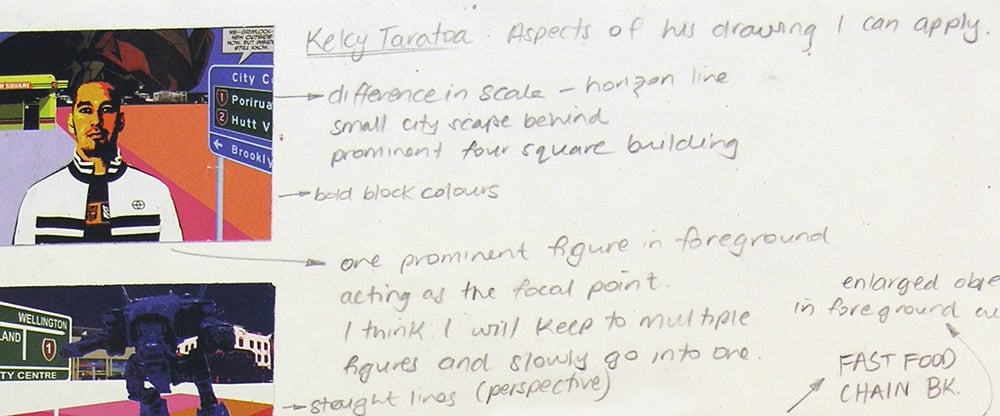
Reference all images, text, and ideas from other sources
All content from other sources should be formally acknowledged and credited. This is true even when you are interpreting the content rather than directly copying it. It is helpful to cite the artist underneath the relevant image (artist name, artwork title, media, date, and image source). Also, provide brief details about any visits to studios, galleries, or museums, noting that you visited in person. Label any original photographs so that it is clear to the examiner which images are your own.

Critically analyze artwork
Art analysis is an integral component of most high school art programs. Make sure you also analyze your own artwork, appraising the outcomes against your original intentions and the assessment objectives. These insights should inform and influence subsequent work.

For further assistance with sketchbook annotation, please read our guide to analyzing artwork . This is a comprehensive art annotation help sheet, with art annotation vocabulary formulated into questions to help guide students through how to annotate an artwork.
Need more help with creating a sketchbook?
This article is part of a series we have published about high school sketchbooks. You may also be interested in viewing our other sketchbook resources:
- Painting / fine art sketchbooks
- Photography sketchbooks
- Graphic design sketchbooks
- Textile and fashion design sketchbooks
- Sculpture, architecture, and 3D Design sketchbooks
- Digital sketchbooks
- Tips for producing an amazing high school sketchbook (this was originally written for A Level Art and IGCSE/GCSE Art students, but is relevant for students creating a sketchbook, art journal, or visual diary as part of any high school art qualification)

Amiria has been an Art & Design teacher and a Curriculum Co-ordinator for seven years, responsible for the course design and assessment of student work in two high-achieving Auckland schools. She has a Bachelor of Architectural Studies, Bachelor of Architecture (First Class Honours) and a Graduate Diploma of Teaching. Amiria is a CIE Accredited Art & Design Coursework Assessor.
JOIN OVER 21,000 PEOPLE WHO RECEIVE OUR FREE NEWSLETTER
You will be notified first when free resources are available: Art project ideas, teaching handouts, printable lesson plans, tips and advice from experienced teachers. What are you waiting for?
Email Address*
We send emails monthly. And don’t worry, we hate spam too! Unsubscribe at any time.

The Art Teacher
Art Lesson Ideas, Plans, Free Resources, Project Plans, and Schemes of Work. An 'outstanding' art teacher in Greater Manchester. Teaching KS3 and KS4 art and design.
Grade 9 GCSE Art Examples
As it is so challenging for students to achieve a Grade 9 in GCSE Art & Design, I thought it would be useful to share some Grade 9 Art project examples. If you’re wondering how to get a Grade 9 in GCSE art, these projects might be able to help!
Email Address
*UPDATE!* I have added more full Grade 9 Art & Design projects to this presentation – there are now FIVE projects to have a look at. Enjoy!
I usually have students work on design sheets so these are photographs of all the design sheets and any final pieces the students made. I was so impressed with their work and with how much effort the students put in! Anyone who teaches (or has done GCSE art) will know it is REALLY difficult to get the top grades and takes a lot of hard work.

There are five Grade 9 full project examples on the presentation, including sheets of student’s secondary and primary research and artist research. As I tell my students, the focus should always be on the quality of their work rather than the quantity in order to achieve high grades in art. Although, of course, they need have enough work to meet all of the four assessment objectives (I currently teach for the AQA exam board.)
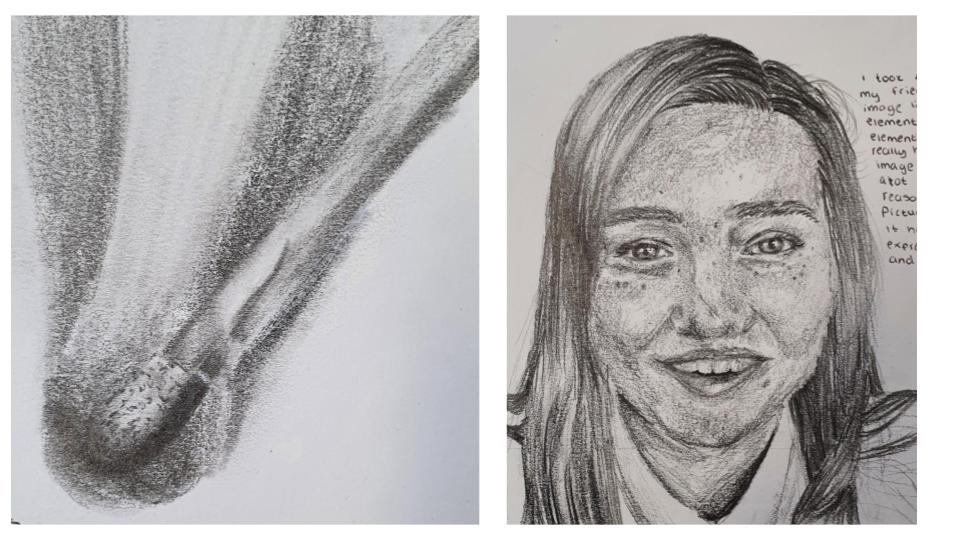
I have also included all of the student’s observational / working drawings, development work, experimentation, plans and final pieces. I have added close up images of the Grade 9 observational drawing work so you can use the presentation to show your own students if you wish.

I have chosen very different exam projects so you can see a full range of techniques and approaches to the different exam questions. The projects are a mix of coursework and the externally set exam by AQA.

I have added titles to each of the slides in ‘student speak’ so your students can clearly see examples of what each stage of a Grade 9 art project looks like. All of the annotations should be legible too!
Finally, I have included photographs of all of the final pieces completed in the 10 hour exam / controlled assessment. As well as the final pieces, I have included close up images so you can clearly see the details and quality of the work. In total, there are 85 slides with examples of Grade 9 GCSE art projects.
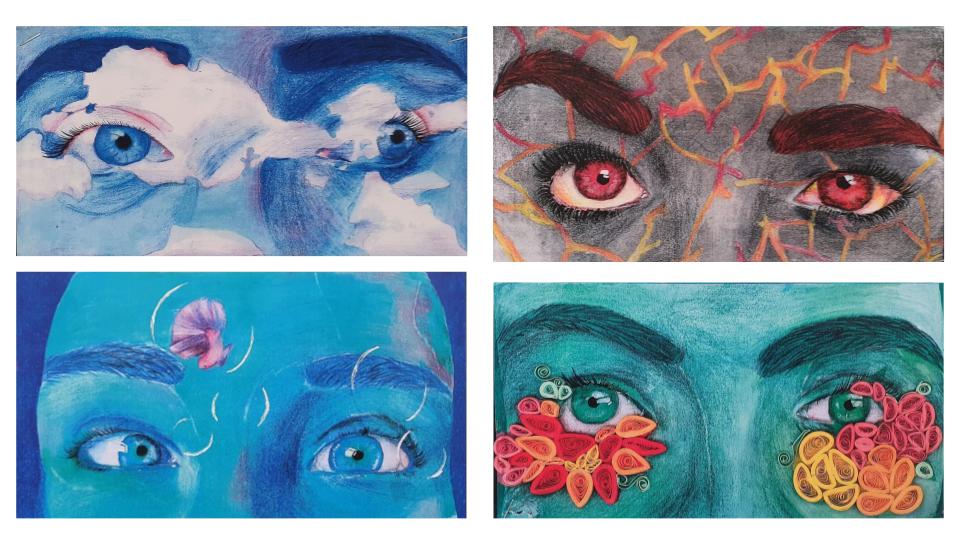
Since some of these art projects were for the externally set exam, the marks made up 40% of the total grade. All students achieved a Grade 9, but that is also including the 60% coursework component.
That means that not every single drawing or experiment in the presentation is a grade 9 . This is important as students can refine their work by recognising what has not gone well and move forward using only their best work! This is tricky to get across to students but hopefully using this presentation will help. I have used it with my own classes and found it useful.
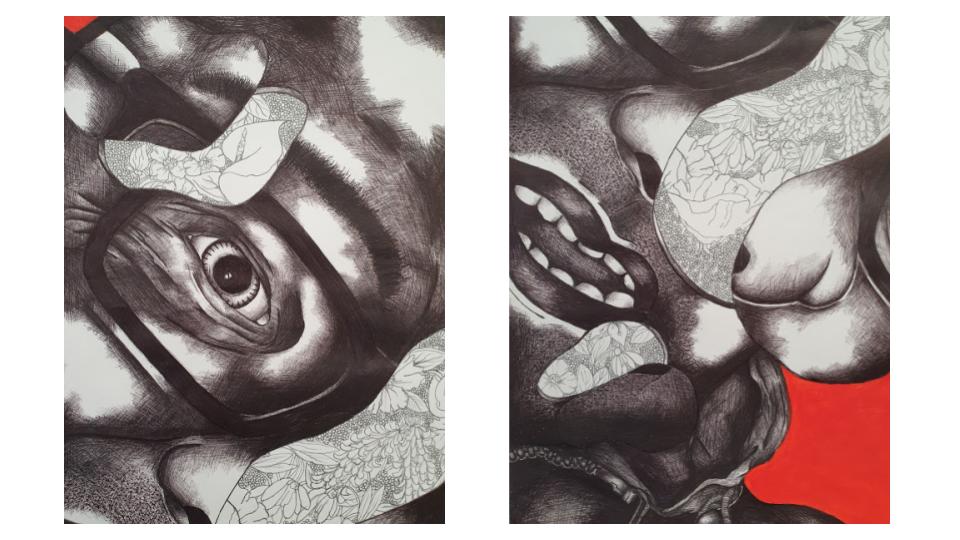
If you would like a copy of the Grade 9 Art presentation for free, just leave a comment and I will share it with your email address! Thanks, I hope this is useful 🎨

Could you make a small donation to help keep this site free? It is getting more expensive to keep online – thanks!
Sharing is caring
198 thoughts on “ grade 9 gcse art examples ”.
Hi! Looks amazing, would love to have a copy if possible as I am currently doing my exam project.
Thanks so much.
Like Liked by 1 person
Hi, yes of course! Hopefully this will help your students through their exams – it’s a stressful time.
These are great. Please could I have a copy too?
Yes of course, I just sent it 🙂
Superb ideas
Hi , this is really helpful advice and resources. Thanks for posting. Could you please send me a copy?
Hi, you’re welcome! Thanks for your message 🙂 I just shared it.
Hi, thanks! I still use it too with my students 🙂 I’ve just shared it!
These resources are WONDERFUL! Thank you for posting them.
You’re welcome! Thanks for your lovely comment 🙂
Really find this site useful! Could I please have a copy to show my GCSE Art students.
I’m really glad it’s helpful 🙂 I just sent the presentation.
Hi , I would love a copy to show my students- thanks.
Hi, no probs – I just sent it over 🙂
Great! thanks so much, a wonderful resource.
This is great and useful to show the students, especially the not everything has to be perfect!
Thanks for your comment! I just sent it over – hopefully it’s helpful for your students. I use it all the time with my GCSE Art classes 🙂
This is really beautiful work! It would be really beneficial to show my students the jouney and development of some great projects 🙂
Hi – I just shared it, I hope your students find it useful! Mine tend to get a better understanding of what is expected when I go through this 🙂
I love this! Would I be able to be sent a copy?
I’m glad you like it 🙂 I have just shared it with you!
this looks so helpful! My daugher is near the end of year 10 and woudl love to see the presentation
I just shared it – I hope your daughter finds it useful!
This would be really useful for my daughter in Y10.
This is amazing and would help my students a lot. Could you please share the presentation with me?
Hi, yes of course, I just sent it 🙂
Many thanks for this 🙂
Love your work – I looking to support my daughter whose work is incredible but she’s not finding her teacher very supportive
I have just shared it – I hope your daughter finds it helpful!
Really well put together. I am sure it will be helpful for many students. Thank you so much for sharing.
Thank you! I just sent it over 🙂
Thank you for sharing. So so helpful. If not too late please could I see a copy of the full presentation?
You’re welcome! And it’s not too late 🙂 I just shared it.
Hi, can I please get a copy? Thank you.
Hi, yes of course – I just sent it 🙂
Very comprehensive and informative. Brilliant post. New to the art teaching world so this would be amazing to have a copy to show students.
Thanks so much for your comment! I’ve just shared it, best wishes for your new career!
This is so inspiring! I am a new teacher and I’d love a free copy of the grade 9 art presentation. Thank you
Thanks for your comment, I’m glad you find it helpful! I just emailed it to you 🙂
Fabulous stuff, would love a copy of the presentation to support a friend’s daughter who is doing her Art GCSE!
Hi, no problem, I just sent it! Best of luck to your friend’s daughter 🙂
Hey there, thank you for such an excellent resource, this would be great in helping me support my daughter who is doing her Art GCSE.
Thanks for your comment! I just sent it – best of luck to your daughter 🙂
This is very useful. Please could we have a copy. Thx!
Hi, yes of course – I just shared it.
Please can you send a copy of the gcse presentation, thanks
I have just shared it with you – thanks!
Please could I have a copy of the presentation. Thx!
I have just shared it 🙂
Sorry I got a message to say it couldn’t be sent to your email address – please double check you’ve given the correct email?
Hi! We would love a copy of your presentation. It would be so helpful!
I just sent it – hope it helps!
Very interesting, thank you. Please may I have the copy?
Would love this! please could I have a copy?
Yes, no problem!
Fabulous resource, pease could I have a copy
This is a great idea, please could I have a copy. Thank you
Thanks! I just sent it over.
Hi, can I get a copy to share with students please.
Hi, I have just shared it 🙂 thanks.
This is really helpful. Please may I have a copy?
Hi, yes of course, I have sent it over.
Hi, please could I get a copy for my son? He has not had an art teacher for most of his GCSE time and is getting very concerned about completing his coursework! Many thanks
Sorry to hear that – hopefully this will help him out a bit 🙂
Hi, I would love a copy, thank you!
I have just shared it with you – enjoy!
Such a great inspiration for teachers, parents and pupils…thank you for taking the time to put all this together xx
Thanks so much, glad you appreciate it 🙂 I just shared it.
Please could I have a copy? Thanks so much.
Yes, I have just shared it 🙂 hope it’s helpful!
Hello! So pleased to come across these examples. Please could you share the full set with me?
Thanks! Happy to help out, I just sent them over 🙂
Hi, I would like a copy please. Thank you.
No problem, I just shared it.
Please could I have a copy? I would find it very useful, thankyou.
Thank you for doing this, some fabulous original ideas. I would love a copy please, I think it will help a number of students looking for more information.
Thanks! It’s all the student’s work so credit to them 🙂
Could this non-arty mum have a copy please? It would be very helpful, thanks.
Of course! And there’s no such thing as non-arty 🙂 there’s no right or wrong!
This is extremely helpful! Please could I have a copy sent across? Thankyou in advance 🙂
I have just sent it over, hope it helps you out!
Hi! What a wonderful idea to share examples in this way as it’s so difficult to know what to do to achieve the top grades! Please could you send me the slideshow? Many thanks!
Thanks for your comment! I have just shared it, I hope it’s helpful.
hi these are great, could I get a copy? X
Thanks! I have sent it to you 🙂
this is invaluable, would be ever so grateful of a new copy as an ECT. Many thanks
No problem 🙂 congrats on becoming an ECT too!
Would love a copy please! 🙂
I just shared it 🙂
Leave a comment Cancel reply
Published by art_teacher_mcr
Making and teaching art. Based in Manchester. View all posts by art_teacher_mcr

- Already have a WordPress.com account? Log in now.
- Subscribe Subscribed
- Copy shortlink
- Report this content
- View post in Reader
- Manage subscriptions
- Collapse this bar

Sketchbooks Research Guide
Introduction.
- Sketchbooks for Artistic Education
- Travel Sketchbooks
- Project-specific Sketchbooks
- Sketchbooks of Everyday Life
- 20th-century Architecture and Design Sketchbooks
- Model Books, Albums, and Other Bound Volumes of Drawings
- Loose Folios from Sketchbooks
- Facsimiles of Sketchbooks in the Getty Library
This research guide was created in 2022-2023 by Sarah Sherman Clark, Elizabeth Poorman, and Naoko Takahatake and is managed by the Getty Library.
Author: Elizabeth H. Bernick (Getty Graduate Intern 2021-2022)
Additional links and information may be added over time.
Please send any additions, corrections, or other suggestions to [email protected]

Sketchbooks in the Getty Research Institute (GRI) and J. Paul Getty Museum: A Research Guide
Defining a Sketchbook
A sketchbook is best defined by its physical construction and the nature of the drawings it contains. A sketchbook is a gathering of paper that is bound together (most often stitched together along one edge) and held within two covers, which can range from cheap cardboard, to cloth, to gold-embossed leather. The term sketchbook connotes its drawings are just that—sketches. Over the centuries, artists have turned to their sketchbooks to jot down visual ideas, seize a sudden burst of inspiration, try out different concepts, or record what they see before them in any given moment. It is therefore implied that sketchbook drawings are personal and informal, and that a sketchbook can be highly flexible in its intended function.
Leonardo da Vinci (1452–1519) was among the earliest European artists trained from a young age to make quick, spontaneous sketches and capture ideas for further exploration. He advised painters to always carry a “small book” so that they could draw anytime, anywhere. This may seem unremarkable today, but in the late 1400s the very concept of a “sketch” was revolutionary, and paper was a valuable commodity. In the following centuries, as European artists more routinely turned to sketching and expanded the use of sketchbooks, prefabricated, mass-marketed sketchbooks became widely available.
Despite this long and rich tradition, very few sketchbooks have come down to us in their original form. Sketchbooks were commonly broken up, their drawings dispersed as loose sheets. The GRI’s Special Collections are exceptional in holding dozens of sketchbooks by artists, designers, and architects in the West from the 17 th to the 21 st centuries, which are still largely intact. Many of these sketchbooks entered the GRI as part of artists’ archives, which can provide important additional context for their study. Handling sketchbooks—turning the pages, tracing the artist’s thoughts from folio to folio—offers insights into an artist’s creative process and biography. Such viewing illuminates how these rare objects were originally assembled, used, and valued.
How to Use This Research Guide
This guide is arranged according to the sketchbooks’ primary functions and uses, highlighting strengths of the GRI’s Special Collections, which are centered in the Western tradition. Within each section, a small selection of sketchbooks and drawings is discussed chronologically. Hyperlinks will take you either to a scan of the sketchbook, or, if not yet digitized, to the library catalog record. If you would like to visit the Getty Library to consult a sketchbook in person, please review the Library’s access policies and contact the library to make an appointment in the Special Collections Reading Room.
Banner image: William Gell, Wall frescoes excavated in Pompeii, ca. 1830, Getty Research Institute, 2002.M.16 Box 425
- Next: Sketchbooks for Artistic Education >>
- Last Updated: Nov 2, 2023 11:26 AM
- URL: https://getty.libguides.com/sketchbooks
- Event Calendar
- Museum Education
- e-Newsletters
- ©J. Paul Getty Trust
- Privacy Policy
- Terms of Use
Artist Research Pages

- International
- Schools directory
- Resources Jobs Schools directory News Search
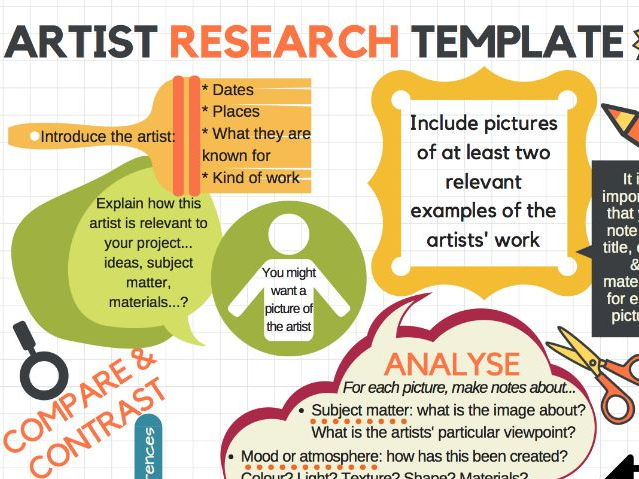
Artist research template - handout/poster
Subject: Art and design
Age range: 11-14
Resource type: Other
Last updated
25 October 2022
- Share through email
- Share through twitter
- Share through linkedin
- Share through facebook
- Share through pinterest

Want to improve the quality of your students artist research? This PDF poster aims to guide students guidance and inspiration to produce excellent artist research pages. Primary targets are KS4, but can be used equally with KS3 and KS5. Two versions are included: A3 and A4 printables - stick them up as display for constant reference or photocopy for sketchbooks or focused research lesson. Soon enough they’ll be in the habit of producing great research!
Tes paid licence How can I reuse this?
Your rating is required to reflect your happiness.
It's good to leave some feedback.
Something went wrong, please try again later.
annaschutz23
Excellent resource - saved me so much time!
Empty reply does not make any sense for the end user
Fidgetrainbowtree
Report this resource to let us know if it violates our terms and conditions. Our customer service team will review your report and will be in touch.
Not quite what you were looking for? Search by keyword to find the right resource:

IMAGES
VIDEO
COMMENTS
Many successful artist research pages are also embellished so the whole page is a reflection of the artist's work. Every aspect of the research page below reflects the artist Ian Murphy. It shows the artists name and includes annotation and images. The student has created a drawing in the bottom left-hand corner inspired by the artists work.
Hi everyone! In this video I take you through the structure I use to write about artists work to ensure you cover everything in your image analysis! I hope y...
These International GCSE Art sketchbook pages were created by Nikau Hindin, while at ACG Parnell College, Auckland, New Zealand.This page includes first-hand observational drawings of a still life arrangement and a handmade flax (harakeke) flower, made by Nikau. You may wish to view Nikau's full A* IGCSE Coursework project (98%) or her AS Coursework project (awarded 100%).
This IB Visual Art sketchbook page is by Allison Ho from Sha Tin College. Note how screenshots of work in Adobe Photoshop (top right) document stages of progress. This helps to verify authenticity of work, so that examiners are clear that the work was produced by the student. ... Artist research. The sketchbook is an excellent place to document ...
GCSE Artist Research Guide. Creating research about artists is a creative and exciting part of a GCSE course. It will allow you to discover new artworks and learn about how artists think and work. This GCSE artist research guide will help you find an appropriate artist, analyse their work and present your research to a GCSE standard.
I use a few materials in this video, if any are of any interest I have listed the materials in the link below. :)EQUIPMENT I USE TO CREATE MY VIDEOSphone/cam...
This one-page resources is a simple list of do's and don'ts. For example, don't refer to an artist by their first name only, don't use pictures the size of stamps, do create an even spread of images and text. There are 16 do's and don'ts and as this is an editable Word document you can edit and update this to suit your own needs.
A guide for GCSE and A Level Art and Design students on what to include and how to layout Artist Research for Assessment Objective 1. Using the work of Tim J...
Artist Ian Murphy creates drawings, paintings, prints and mixed-media pieces inspired by architecture and different textures. As well as using his sketchbook to draw and think about his ideas, he makes large-scale work and uses lots of materials to create distressed surfaces that he paints and draws over the top of. Venetian Scroll. Oil paint,…
A sketchbook page can sometimes be treated as a gallery space upon which quality artwork can be 'hung'. In this example, the image on the left - a clever photographic representation of a conceptual idea - is celebrated, with text quietly balancing the layout on the right. An A Level Photography sketchbook by Emily Betts.
Artist Research 1 - Complete a minimum of one double page on an appropriate artist. Include: Artist Research 2 - Complete a minimum of one double page on a second appropriate artist. Include: 5 Mount up all artist research onto paper/into sketchbooks using the method described above 2 pages 2 pages
Research shows revisiting information is essential to remembering information. You then ask them to close their books. Then, all the students stand up. You randomly choose a student to say the first fact. They say it and then choose the next student to say a fact. To start with, they have to choose a student who has not been chosen.
Notes from Class: Things that Mr. A. asks you to include in your sketchbooks (I.E. Value Scales, Color wheel) In addition to notes that you may take during the lessons presented in class. The Page should be created in the style of the Artist! Artist Research Page: A page dedicated to an Artist (Artist can be Visual, Literary, Craftsman, etc.)
This AQA A Level Art sketchbook annotation is by Daisy Wrigley, completed while studying at St Mary's Catholic High School. Referencing the work of Crystal Neubauer, Daisy explains why she has used particular media, and how these choices support the intentions within her work. Daisy achieved 98% for A Level Art.
Details of a Grade 9 GCSE art final piece. Since some of these art projects were for the externally set exam, the marks made up 40% of the total grade. All students achieved a Grade 9, but that is also including the 60% coursework component. That means that not every single drawing or experiment in the presentation is a grade 9.
May 21, 2020 - Explore Lauren of Arabia's board "Artist Research Sketchbook Pages" on Pinterest. See more ideas about sketchbook layout, gcse art sketchbook, a level art sketchbook.
What should artist research look like? •It's up to you how your research pages are laid out •They should be as individual as the rest of your sketchbook
Sketchbooks were commonly broken up, their drawings dispersed as loose sheets. The GRI's Special Collections are exceptional in holding dozens of sketchbooks by artists, designers, and architects in the West from the 17 th to the 21 st centuries, which are still largely intact. Many of these sketchbooks entered the GRI as part of artists ...
This A Level sketchbook page shows an artist study - formal analysis of the work of Francis Bacon alongside Lucy's own experimentation. Adobe Photoshop has been used to distort original photographs, before creating a monoprint of the image and overlaying other images printed onto acetate. Supporting artist works can be seen alongside, including ...
Artist Research Pages. Sketchbook Ideas. A* sketchbook. Page on Julian Opie. I used coloured paper and stick notes, because I thought it goes well with the artists style. #sketchbook #artbook. My work in the style of Julian Opie. On the left I have a three step diagram of how I gone about making it and on the right is the final piece.
A Level Art. Art Alevel. A1 Fine Art A3 Brown Sketchbook Henry Moore Research and Study Exploring Media Thomas Rotherham College 2018. Dec 8, 2018 - Explore Laugutu Poloai's board "artist research page" on Pinterest. See more ideas about gcse art sketchbook, artist research page, sketch book.
This PDF poster aims to guide students guidance and inspiration to produce excellent artist research pages. Primary targets are KS4, but can be used equally with KS3 and KS5. Two versions are included: A3 and A4 printables - stick them up as display for constant reference or photocopy for sketchbooks or focused research lesson.
Jan 20, 2014 - Explore mrs tyler-ward's board "artist research page examples" on Pinterest. See more ideas about artist research page, sketch book, artist.